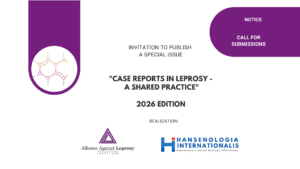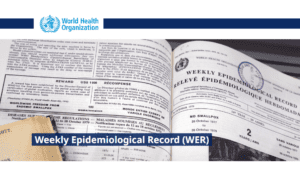Nesta sexta-feira, 4 de outubro, a Diretoria Executiva do Instituto @aliancacontrahanseniase e a Direção Editorial da Revista Hansenologia Internationalis realizaram a cerimônia de premiação dos três melhores relatos de casos submetidos por meio do edital HI e AAL para o fascículo especial da revista científica.




Na foto 1, os troféus. . Foto 2: Discurso da Sabha Mushtaq, primeira colocada na premiação. Foto 3: participantes presenciais e remotos na cerimônia de premiaçãoFoto 4: cheque cenográfico da premiação do primeiro lugar.
Confira aqui a lista completa dos ganhadores:
- 1º Lugar:
Ulcerative type 1 lepra reaction in borderline tuberculoid leprosy: A rare presentation;
Reação tipo 1 ulcerativa em hanseníase dimorfo-tuberculóide: uma apresentação rara
Reacción tipo 1 ulcerativa en la lepra dimorfo-tuberculoide: una presentación rara
Autora: Dra. Sabha Mushtaq
Disponível em: https://periodicos.saude.sp.gov.br/hansenologia/article/view/40191/38202
ABSTRACT Introduction:
leprosy is a chronic infectious disease caused by Mycobacterium leprae, characterized by a wide spectrum of clinical presentations. In India, borderline-tuberculoid leprosy is the most common form encountered in clinical practice. Type 1 lepra reaction in borderline-tuberculoid leprosy usually presents as the development of erythema and/or edemain pre-existing skin lesions. Ulceration of skin lesions in type 1 lepra reaction is uncommon and occurs in severe reactions. Objective: to report an unusual presentation of borderline-tuberculoid leprosy with ulcerative type 1 lepra reaction inan immunocompetent patient. Case description: we present the case of a 65-year-old man with chief complaints of ulcerated plaque over his left thigh. He also had other skin lesions suggestive of borderline-tuberculoid leprosy over his trunk and limbs, as well as enlarged, mildly tender left ulnar and lateral popliteal nerves. A slit skin smear was negative, while a skinbiopsy supported the diagnosis of borderline-tuberculoid leprosy. The patient responded to multibacillary multidrug therapy according recommended by World Health Organization and tapering doses of prednisolone, with complete healing of theulceration at six weeks follow-up. Discussion: type 1 lepra reaction associated with borderline-tuberculoid leprosy usually presentswith increased erythema and edema in pre-existing skin lesions. Ulceration in such skin lesions is not commonly seen except incases with severe type 1 leprosy reactions. Administration of oral corticosteroids along with multibacillary multidrug therapy is the keyto managing ulcerative type 1 lepra reaction. The ulceration heals rapidly with tapering doses of oral corticosteroids, limiting theduration of morbidity. Final consideration: the case emphasizes the need for dermatologists and leprologists to be aware of atypicalpresentations of leprosy reactions, ensuring timely diagnosis and effective management to achieve optimal patient outcomes.
_
- 2º Lugar:
Concomitância da hanseníase virchowiana e carcinoma de células escamosas: relato de caso;
Concomitance of lepromatous leprosy and squamous cell carcinoma: case report;
Concomitancia entre lepra lepromatosa y carcinoma de células escamosas: reporte de caso;
Autores: Hugo Hatanaka, Bruno de Carvalho Dornelas, Pauline Dias Soares Girardi, Caio Oliveira Sena, Marcelo CamposRocha, Isabela Maria Bernardes Goulart
Disponível em: https://periodicos.saude.sp.gov.br/hansenologia/article/view/40198/38198
ABSTRACT Introduction
: leprosy is an endemic disease in Brazil, ranking second worldwide for the number of new cases diagnosed yearly. However, late diagnosis of this disease is still common. Objective: to alert health professionals to theimportance of recognizing the insidious signs of leprosy, both clinical and histopathological, even in the presence of other,more apparent alterations. Presentation and discussion of the case: a man with skin lesions suggestive of squamous cellcarcinoma. On histological examination, besides the carcinoma, there were aggregates of foamy macrophages full of acid-fast bacilli compatible with lepromatous leprosy. A more detailed physical examination by a multidisciplinary team from a nationalreference center also revealed skin with a diffuse infiltrated appearance and supraciliary madarosis, alterations not noticed in the first evaluation at another service. Final considerations: this case can help clinical professionals and pathologists pay attention to skin alterations that can make it challenging to diagnose leprosy, especially in endemic regions, to enable earlydiagnosis and reduce the disabilities related to the disease.
- 3º Lugar:
Valor diagnóstico da PCR quantitativa em acompanhamento de um paciente com hanseníase: relato de caso.
Quantitative PCR diagnostic value in monitoring a patient with leprosy: case report
Valor diagnóstico de la PCR cuantitativa en el seguimiento de un paciente con lepra: reporte de un caso
Autores: Marcos Daniel Silva Pinheiro, Maisa Pereira Vieira, Daisy Cristina Monteiro dos Santos, Alexandre Castelo Branco, LorenaBruna Pereira de Oliveira, Lucia Alves de Oliveira Fraga.
Disponível em: https://periodicos.saude.sp.gov.br/hansenologia/article/view/40201/38180
ABSTRACT Introduction:
leprosy is a chronic granulomatous disease caused by Mycobacterium leprae. Objective: the study aims to report the follow-up of a patient with leprosy, presenting a positive quantitative polymerase chain reaction (qPCR).Case description: the patient is a 53-year-old male residing in the rural area of São Geraldo da Piedade, Minas Gerais State, Brazil. In 2015, the patient sought care at the Governador Valadares Municipal Central Polyclinic and was referred to the Dr. Alexandre Castelo Branco Reference Center for Endemic Diseases and Special Programs (CREDEN-PES) to initiate treatment. However, he did not adhere to the therapy, citing difficulty accessing the center. In 2017, he returned to CREDEN-PES, where he was examined and collected material for bacilloscopy and qPCR. The bacilloscopy index (BI) result was zeroand positive for qPCR. The patient was referred for treatment in his hometown and adhered to two doses of multibacillarymultidrug therapy (MB-MDT). In 2021, he sought CREDEN-PES for new evaluations, resulting in BI = 1.5 and decreased plantarsensitivity.
He began a unique treatment regimen for leprosy (U-MDT). In 2023, he moved to Paraná State and recently reported hiscondition: regular health, altered balance, frequent falls, loss of strength in the knees, dry skin, and swelling behind the ear.The positivity of the qPCR reaction prompted the team to follow up with this patient, who initially did not adhere to the treatment.Conclusion: it is believed that using laboratory tools to assist and reinforce the diagnosis and treatment has contributed to moreeffective leprosy control
Parabenizamos aos ganhadores e a todos os pesquisadores(as) e cientistas que enviaram os casos e estão contribuindo, de maneira exemplar, para o combate da hanseníase no mundo.
Leia o fascículo especial na íntegra em: https://periodicos.saude.sp.gov.br/index.php/hansenologia
Você também é um pesquisador da área de hanseníase, entre em contato com o Instituto AAL.
#aal #ilsl #revistaHI #dralailadelaguiche #hansen #leprosy #hanseniase #melhoresongs2024 #bauru #ciencia #institutoAAL









